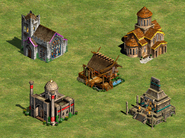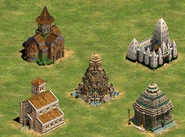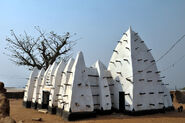| This article is about the building in Age of Empires II. For related buildings in other games of the series, see Monastery. |
| “ | Used to create and improve Monks. Garrisoned relics generate gold. | ” |
| —Age of Empires II description | ||
The Monastery is a special building in Age of Empires II that becomes available once the Castle Age is reached. It trains and improves Monks.
Relics can be garrisoned in Monasteries to produce gold. Monasteries cannot be converted.
Tactics and placement
Monasteries mainly serve as a Monk production building. As Monks are important for supporting and healing troops players will normally build at least two Monasteries for that purpose. If the player is intending to use their Monks for offensive purposes like a Mush (Monk rush) they must have at least three (preferably four) Monasteries since the production of Monks is slow and the unit itself has slow movement. Also, technologies must be researched at the same time, first of all Sanctity and Fervor.
Some technologies in the Monastery also help against enemy Monks or are supportive for troops (Faith, Heresy, and Herbal Medicine) so it is advisable to also have a Monastery even if the player does not make use of Monks.
Monasteries also have economic relevance. Each Monastery can hold 10 Relics, constantly producing gold with each one garrisoned. Especially in games with no teams Relics become important in the late game, as they are usually the only way left to get gold at all. Often, the player holding the most Relics wins a long game.
Lastly, Monasteries can be of key importance in any game with standard victory condition. If a team holds all Relics in their Monasteries, a counter starts to count down from 200 years, similar to when a Wonder is built. If the enemy team (or teams) fails to ungarrison at least one Relic before the counter reaches zero, the game is won. If a team goes for a Relic win, it is advised to garrison all Relics in a single Monastery and massively defend that Monastery with defensive structures and heavy units, preferably ranged units, heavy cavalry, and siege equipment. In any case the defenses should be built before the last Relic is garrisoned. Ideally, the opposing team does not even notice the effort and is left surprised. This victory condition may also serve as a distraction against the rival team if the team has several Monasteries holding Relics: one Monastery (usually the best defended) can hold most of them and the others just one in order to become dummies.
If the game mode Capture the Relic is chosen, every player starts the game with an indestructible Monastery and attempts to garrison the only Relic (which is sitting in the very center of the map at the game start) in their Monastery. The first player to achieve that wins the game.
Trainable units and technologies
Clicking on the icon links to the corresponding page.
- Blue: Units
- Green: Technologies
- Purple: Unique units

|
→ | 
|
→ | 
|
→ | 
|

|

| |||||

|

| |||||

|

| |||||

|

| |||||

|
||||||

|
||||||

|
||||||

|
Availability grid
The following table shows the availability of the technologies for every civilization. An 'X' in the last column indicates that all technologies are available.
 = Available
= Available- File:Unavailable.png = Unavailable
| Civilization | All | ||||||||||
|---|---|---|---|---|---|---|---|---|---|---|---|
| X | |||||||||||
| X | |||||||||||
| X | |||||||||||
| X | |||||||||||
| X | |||||||||||
| Civilization | All |
Further statistics
| Building strengths and weaknesses | |
|---|---|
| Strong vs. | Nothing |
| Weak vs. | Everything except Monks |
| Upgrades | |
| Hit points | |
| Armor | |
| Line of Sight | |
| Construction speed | |
| Other | |
Civilization bonuses
- Aztecs: Monks gain 5 HP for every researched Monastery technology.
- Burmese: Monastery technologies are 50% cheaper.
- Byzantines: Monasteries have +30%/+40% HP in the Castle/Imperial Age. Town Watch is free.
- Chinese: Technologies that benefit Monasteries and Monastery technologies are 15%/20% cheaper in the Castle/Imperial Age.
- Lithuanians: Knights and Leitis gain +1 attack for each Relic garrisoned in a Monastery (up to +4).
- Malians: Monasteries are 15% cheaper.
- Persians: Researching Town Watch and Town Patrol is 10%/15%/20% faster in the Feudal/Castle/Imperial Age.
- Portuguese: Monks are 15% cheaper.
- Spanish: Monasteries are built 30% faster.
Team bonuses
- A team containing Aztecs: Relics generate 33% more gold.
- A team containing Lithuanians: Monasteries work 20% faster.
- A team containing Malians: Researching Masonry, Architecture, and Treadmill Crane is 80% faster.
Changelog
The Conquerors
- Heresy technology introduced.
- Herbal Medicine technology introduced.
- Theocracy technology introduced.
Architecture
Naturally, each architecture style has its own design for the Monastery. The architectural traits from the real world are listed below.
- The Western European Monastery has a distinct Gothic style.
- The Central European Monastery has some Romanesque traits and is almost identical to Gelati Monastery in Georgia.
- The Middle Eastern Monastery is supposed to be a general representation of a mosque. Since the Byzantines, who are Christian, had that architecture prior to the Definitive Edition, the Muslim architectural traits are not extreme.
- The East Asian Monastery is a generic Japanese shrine combining elements from both Shinto shrines (Torii gate) and Japanese Buddhist temples (Bonshō bell).
- The Native American Monastery represents temples used for ritual sacrifices and bloodletting.
- Although the Eastern European Monastery is mostly just a copy of the Central European one, it does architecturally resemble the church of Akos and St. John's Church in Malbork. The new Eastern European Monastery appears to be based on generic Eastern Orthodox churches.
- The Southeast Asian Monastery resembles buildings in the interior of Angkor Wat.
- The African Monastery is based on the Larabanga Mosque.
- The Indian Monastery is based on the Konark Sun Temple.
- The Mediterranean Monastery features architectural elements of both Gothic and Romanic architecture. This combination is typical in Northern Italian churches and cathedrals, as well as in some chapels throughout Tuscany, Marche, and Umbria.
History
| “ | Monasteries were closed religious communities to which particularly devout priests, scholars, and believers withdrew for a life of prayer, study, and service. Monastic life was embraced by several religions, including Christianity and Buddhism. Residents of monasteries became known as monks. In parts of Dark Age Europe, monasteries were the only remaining centers of learning. Irish monks, for example, were instrumental in preserving much ancient knowledge and spreading it back into Europe as the Dark Ages waned. Over time monasteries grew rich in donated land. They became very important local institutions as a source of educated men who could serve as administrators. They also provided health care and emergency relief from their stockpiles of food. | ” |
Gallery
Template:Buildings AoE2



